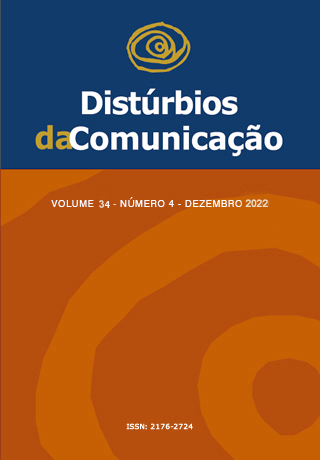Parents’ perceptions about the participation and communication of their children with non-speaking cerebral palsy
DOI:
https://doi.org/10.23925/2176-2724.2022v34i4e58425Keywords:
Disabled Children, Cerebral Palsy, Language Development, Communication Barriers, Communication Aids for Disabled, Social InclusionAbstract
Introduction: Knowing family members’ perceptions about the participation and communication of their children with non-speaking CP (Cerebral Palsy), contributes to educational and therapeutic processes centered on the person and family. Aim: Become acquainted with participation and communication aspects of children and adolescents with non-speaking CP, as well as factors that favor or hinder AAC (Augmentative Alternative Communication) use in the family environment and school. Method: Descriptive and cross-sectional study with a qualitative approach, with a sample of five mothers of students with non-speaking CP. Results: Mothers report barriers to their children’s participation and recognize the importance of communication in family interactions and activities. They mention not having achieved functional use of AAC at home, but express satisfaction with the level of communication they have with their children. On the other hand, they address communication difficulties when they are unable to identify their children’s wishes or when their children are with other interlocutors. Conclusion: The findings show reduced participation of the children and the adolescent in the study, as well as little or no AAC use. In view of the difficulties reported by the participants, the findings reinforce the need to equip family members, in order to promote these children’s communication and participation. The importance of AAC professionals and special education teachers working in partnerships with families is reinforced. These professionals can help expand the ways in which mothers interact and communicate with their children, and vice versa, aiming at greater participation among them.
Downloads
References
Imms C, Reilly S, Carlin J, Dodd K. Diversity of participation in children with cerebral palsy. Dev Med Child Neurol. 2008; 50(5): 363-9.
OMS. Centro Colaborador da Organização Mundial de Saúde para a família das Classificações Internacionais (org.). CIF: Classificação Internacional de Funcionalidade, Incapacidade e Saúde. São Paulo: EDUSP; 2020.
Humphry R. Young Children’s Occupations: Explicating the Dynamics of Developmental Processes. Am J. Occup Ther. 2002; 56(2): 171-9.
Wiseman JO, Davis JA, Polatajko HJ. Occupational Development: Towards an Understanding of Children’s Doing. J. Occup. Sci. 2005; 12(1): 26-35.
Law M, Finkelman S, Hurley P, Rosenbaum P, King S, King G. et al. Participation of children with physical disabilities: relationships with diagnosis, physical function, and demographic variables. Scand. J. Occup. Ther. 2004; 11(4): 156-62.
Alam SM, Ahmed M, Arif KEK, Begum S. Social Participation of Children with Communication Disability: An Observation from Bangladesh. IJARIIE. 2018; 4(6): 310-9.
Smith AL, Hustad KC. AAC and Early Intervention for Children with Cerebral Palsy: Parent Perceptions and Child Risk Factors. Augment Altern Commun. 2015; 31(4): 336-50.
Mandak K, Light J. Family-centered services for children with complex communication needs: the practices and beliefs of school-based speech-language pathologists. Augment Altern Commun. 2018; 34(2): 130-42.
Mandak K, O’Neill T, Light J, Fosco GM. Bridging the gap from values to actions: a family systems framework for family-centered AAC services. Augment Altern Commun. 2017; 33(1): 32-41.
Chun RYS, Romano N, Zerbeto AB, Moreira EC. Comunicação Suplementar e/ou Alternativa no Brasil: Ampliação de territórios e saberes científicos e locais. In: Chun RYS, Reily LH, Moreira CE (Orgs.). Comunicação Alternativa: ocupando territórios. São Carlos: Abpee; 2015. p. 17-37.
Bailey RL, Parette HP, Stoner JB, Angell ME, Carroll K. Family members’perceptions of augmentative and alternative communication device use. Lang Speech Hear Serv Sch. 2006; 37(1): 50-60.
Crisp C, Draucker CB, Ellett MLC. Barriers and facilitators to children’s use of speech-generating devices: a descriptive qualitative study of mothers’perspectives. J Spec Pediatr Nurs. 2014; 19(3): 229-37.
Rackensperger T. Family influences and academic success: the perceptions of individuals using AAC. Augment Altern Commun. 2012; 28(2): 106-16.
Guedes-Granzotti RB, Andrade LA, Silva K da, Bicalho ICS, Fukuda MTH, Domenis DR. Adaptação transcultural do Communication Function Classification System para indivíduos com Paralisia Cerebral. Rev CEFAC. 2016; 18(4): 1020-8.
Turato ER. Tratado da metodologia da pesquisa clínico-qualitativa. Petrópolis: Editora Vozes; 2011.
Silva RS da, Fedosse E. Perfil sociodemográfico e qualidade de vida de cuidadores de pessoas com deficiência intelectual. Cad Bras Ter Ocup. 2018; 26(2): 357-66.
Francisco del Rey C, Casas Martínez F. Cuidador familiar. Manual práctico de enfermería comunitaria. Elsevier; 2014. p. 138-47.
Pimenta R de A. Avaliação da qualidade de vida e sobrecarga de cuidadores de pessoas com deficiência intelectual. RBCS. 2010; 14(3): 69-76.
A’Campo LEI, Spliethoff-Kamminga NGA, Macht M, EduPark Consortium, Roos RAC. Caregiver education in Parkinson’s disease: formative evaluation of a standardized program in seven European countries. Qual Life Res. 2010; 19(1): 55-64.
Cesa CC, Mota HB. Comunicação aumentativa e alternativa: panorama dos periódicos brasileiros. Rev CEFAC. 2015; 17(1): 264-9.
Sargent J, Clarke M, Price K, Griffiths T, Swettenham J. Use of eye‐pointing by children with cerebral palsy: what are we looking at? Int J. Lang Comm Dis. 2013; 48(5): 477-85.
Deliberato D, Manzini EJ. Análise de processos comunicativos utilizados por uma criança com Paralisia Cerebral espástica. In: MANZINI, EJ. Educação especial: temas atuais. Marília: Unesp; 2000. p. 35-45.
Deliberato D, Ferreira-Donati GC. Questionário de Necessidades de Informação em Linguagem e Comunicação Alternativa (QNILCA-F) – Versão para Família 1. RBEE. 2017; 23(1): 53-66.
Light J, McNaughton D. Making a difference: A celebration of the 25th anniversary of the International Society for Augmentative and Alternative Communication. Augment Altern Comm. 2008; 24(3): 175-93.
Downloads
Published
Issue
Section
License
Copyright (c) 2023 Ana Carolina Franzolin Araujo Rezende, Paula Mello P. Passos, Regina Yu Shon Chun

This work is licensed under a Creative Commons Attribution 4.0 International License.









